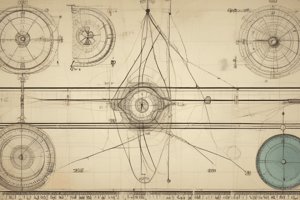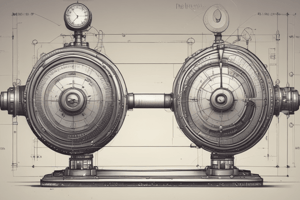Podcast
Questions and Answers
A conversion factor is a numerical value used to add a unit of measurement to another unit.
A conversion factor is a numerical value used to add a unit of measurement to another unit.
False (B)
Dimensional analysis is a method of conversion that involves multiplying the original value by the conversion factor.
Dimensional analysis is a method of conversion that involves multiplying the original value by the conversion factor.
False (B)
The formula to convert Celsius to Fahrenheit is °F = (°C - 32) × 5/9.
The formula to convert Celsius to Fahrenheit is °F = (°C - 32) × 5/9.
False (B)
Rounding errors are a common conversion error that occurs when there is a unit mismatch.
Rounding errors are a common conversion error that occurs when there is a unit mismatch.
Units conversion is only necessary when performing calculations within the same system of measurement.
Units conversion is only necessary when performing calculations within the same system of measurement.
What is the purpose of units conversion?
What is the purpose of units conversion?
Chain conversion involves converting the original measurement to an intermediate unit, and then converting the intermediate unit to the desired unit.
Chain conversion involves converting the original measurement to an intermediate unit, and then converting the intermediate unit to the desired unit.
What is the conversion factor for 1 inch to centimeters?
What is the conversion factor for 1 inch to centimeters?
1 pound is equal to ______________ kilograms.
1 pound is equal to ______________ kilograms.
Match the following units of measurement with their corresponding conversions:
Match the following units of measurement with their corresponding conversions:
Flashcards are hidden until you start studying
Study Notes
Units Conversion
Importance of Units Conversion
- Necessary to perform calculations and comparisons between different measurements
- Enables communication and consistency across different systems and fields
Types of Units Conversion
- Length Conversion
- Between units of the same system (e.g., inches to feet in the Imperial system)
- Between units of different systems (e.g., meters to inches)
- Mass Conversion
- Between units of the same system (e.g., grams to kilograms in the Metric system)
- Between units of different systems (e.g., pounds to kilograms)
- Time Conversion
- Between units of the same system (e.g., seconds to minutes in the SI system)
- Between units of different systems (e.g., hours to seconds)
- Temperature Conversion
- Between Celsius, Fahrenheit, and Kelvin scales
- Conversion formulas:
- Celsius to Fahrenheit: °F = (°C × 9/5) + 32
- Fahrenheit to Celsius: °C = (°F - 32) × 5/9
Conversion Factors
- A conversion factor is a numerical value used to convert a unit of measurement to another unit
- Examples:
- 1 inch = 2.54 centimeters (length conversion factor)
- 1 pound = 0.453592 kilograms (mass conversion factor)
Conversion Methods
- Multiplication by Conversion Factor
- Multiply the original value by the conversion factor to obtain the converted value
- Dimensional Analysis
- Use the units to guide the conversion process, canceling out units as necessary
- Example: converting 5 miles to kilometers (1 mile = 1.60934 kilometers)
Common Conversion Errors
- Unit mismatch: incorrect units in the conversion process
- Rounding errors: loss of precision due to rounding intermediate calculations
- Formula mistakes: incorrect or misapplied conversion formulas
Units Conversion
Importance of Units Conversion
- Essential for performing calculations and comparisons between different measurements
- Enables communication and consistency across different systems and fields
Types of Units Conversion
- Length conversion: between units of the same system (e.g., inches to feet) and different systems (e.g., meters to inches)
- Mass conversion: between units of the same system (e.g., grams to kilograms) and different systems (e.g., pounds to kilograms)
- Time conversion: between units of the same system (e.g., seconds to minutes) and different systems (e.g., hours to seconds)
- Temperature conversion: between Celsius, Fahrenheit, and Kelvin scales using formulas
Conversion Factors
- Numerical values used to convert a unit of measurement to another unit
- Examples: 1 inch = 2.54 cm, 1 pound = 0.453592 kg
Conversion Methods
- Multiplication by conversion factor: multiply original value by conversion factor to obtain converted value
- Dimensional analysis: use units to guide conversion process, canceling out units as necessary
Common Conversion Errors
- Unit mismatch: incorrect units in conversion process
- Rounding errors: loss of precision due to rounding intermediate calculations
- Formula mistakes: incorrect or misapplied conversion formulas
Units Conversion
- Units conversion is the process of changing the units of measurement from one system to another, necessary when dealing with different systems of measurement, such as SI and USCS.
Conversion Factors
- A conversion factor is a numerical value used to convert a measurement from one unit to another.
- Conversion factors are used to convert between units of the same physical quantity, such as length or mass.
Unit Conversion Methods
- Direct Conversion: Multiply the original measurement by a conversion factor to obtain the desired unit.
- Chain Conversion: Convert the original measurement to an intermediate unit, then convert the intermediate unit to the desired unit.
Common Conversions
- Length:
- 1 inch (in) = 2.54 centimeters (cm)
- 1 foot (ft) = 12 inches (in)
- 1 yard (yd) = 3 feet (ft)
- Mass:
- 1 pound (lb) = 0.453592 kilograms (kg)
- 1 ounce (oz) = 28.3495 grams (g)
- Volume:
- 1 fluid ounce (fl oz) = 29.5735 milliliters (mL)
- 1 cup (c) = 236.6 milliliters (mL)
Dimensional Analysis
- Dimensional analysis is a method of converting units by canceling out units and leaving only the desired unit.
- It involves setting up a series of conversions, using conversion factors, to arrive at the desired unit.
Practice Tips
- Always write the conversion factor with the unit you want to convert to in the numerator, and the unit you want to convert from in the denominator.
- Use parentheses to group units and conversion factors to avoid confusion.
- Check your units at each step of the conversion to ensure accuracy.
Studying That Suits You
Use AI to generate personalized quizzes and flashcards to suit your learning preferences.




